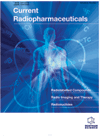- Home
- A-Z Publications
- Current Radiopharmaceuticals
- Previous Issues
- Volume 16, Issue 2, 2023
Current Radiopharmaceuticals - Volume 16, Issue 2, 2023
Volume 16, Issue 2, 2023
-
-
Status of α-emitter Radioimmunoconjugates for Targeted Therapy
More LessAuthors: Rabiei Mobina, Ahmad Reza Vaez Alaei and Hassan YousefniaThis minireview describes the global situation of ongoing research and development and the clinical application of alpha emitter labeled immunoconjugates with various alpha emitters with an overview of the future trends. The potentially helpful alpha emitter radioisotopes for medical applications, chelators, and immunomolecules of interest for future alpha radioimmunotherapy are discussed. Challenges and s Read More
-
-
-
Current State of 44Ti/44Sc Radionuclide Generator Systems and Separation Chemistry
More LessAuthors: Christine E. Schmidt, Leah Gajecki, Melissa A. Deri and Vanessa A. SandersIn recent years, there has been an increased interest in 44Ti/44Sc generators as an onsite source of 44Sc for medical applications without needing a proximal cyclotron. The relatively short half-life (3.97 hours) and high positron branching ratio (94.3%) of 44Sc make it a viable candidate for positron emission tomography (PET) imaging. This review discusses current 44Ti/44Sc generator designs, focusing on their chemistry, dr Read More
-
-
-
An Overview of Radiolabeled RGD Peptides for Theranostic Applications
More LessAuthors: Fateme Badipa, Behrouz Alirezapour and Hassan YousefniaAngiogenesis phenomenon, as a highly affecting factor on the growth and spread of cancer cells, depends on specific molecular interactions between components of the extracellular matrix and vascular cells. αv integrin acts as a cell adhesive molecule involved in tumor invasion and angiogenesis. Among the various combinations of integrin subunits expressed on the surface of cells, αvβ3 integrin has a particularly int Read More
-
-
-
Comparative Study of Extremely Low-Frequency Electromagnetic Field, Radiation, and Temozolomide Administration in Spheroid and Monolayer Forms of the Glioblastoma Cell Line (T98)
More LessBackground: Glioblastoma is the most common primary malignant tumor of the central nervous system. The patient's median survival rate is 13.5 months, so it is necessary to explore new therapeutic approaches. Objective: Extremely low-frequency electromagnetic field (EMF) has been explored as a noninvasive cancer treatment. This study applied the EMF with previous conventional chemoradiotherapy for glioblastoma Read More
-
-
-
Radiopharmaceutical Encapsulated Liposomes as a Novel Radiotracer Im - aging and Drug Delivery Protocol
More LessAuthors: Anfal M. Alkandari, Yasser M. Alsayed and Atallah M. El-hanbalyNuclear medicine specialty involves the administration of unsealed radioactive substances to patients to allow specific diagnostics and treatments using radiopharmaceuticals, radiotracers, and materials. Developing a radiopharmaceutical must involve considering and addressing some limitations such as its retention by unintended organs, which can influence patient and worker safety, imaging findings, and diagnostic a Read More
-
-
-
Investigation of Bioactivity of Estragole Isolated from Basil Plant on Brain Cancer Cell Lines Using Nuclear Method
More LessBackground: In recent years, there has been a significant increase in studies investigating the potential use of plant-origin products in the treatment and diagnosis of different types of cancer. Methods: In this study, Estragole (EST) was isolated from basil leaves via ethanolic extraction using an 80% ethanol concentration. The isolation process was performed using the High Performance Liquid Chromatography (HPLC) Read More
-
-
-
Optimization of SUV with Changing the Dose Amount in F18-FDG PET/CT of Pediatric Lymphoma Patients
More LessAuthors: Nedim Cüneyt Murat Gülaldi, Berkay Cagdas and Fatma A. GörtanAims: We aim to reveal an effect of residual activity leftover within the medical materials other than the empty syringe used for injection of the tracer on SUV measurements and consequently effect on possible treatment response assessment. Background: Staging and follow-up of pediatric lymphoma patients mainly achieved by the help of PET/CT scans. It is crucial to make an optimal imaging technique for interpreting indiv Read More
-
-
-
Evaluation in Terms of Dosimetry and Fertility of F18-FDG and Ga68- PSMA in Prostate Cancer Imaging: A Simulation with GATE
More LessAuthors: Handan T. Kökkülünk and AyŦ#159;e Karadeniz YildirimIntroduction: F18 and Ga68 radioisotopes are used in PET imaging for prostate cancer. It was aimed to calculate the prostate, testicle and bladder effective doses (ED) caused by F18 and Ga68 used in prostate cancer imaging with PET/CT via simulation with the GATE toolkit and evaluate the ED in terms of fertility. Methods: The prostate, testicle and bladder were defined together with their geometric properties and densities in G Read More
-
-
-
Re-Evaluation of Patient-Sourced Radiation Doses in PET/CT
More LessAuthors: Ahmet M. Şenışık, Handan Tanyıldızı Klünk and Mahmut YükselBackground: New generation PET/CT devices provide quality images using low radiopharmaceutical activities. Dose monitoring is carried out for nuclear medicine personnel, other health personnel, and companions by determining the radiation dose emitted from low-activity patients to the environment. In particular, it is necessary to revise the working conditions of the personnel according to the radiation dose exposed. Ai Read More
-
Most Read This Month
Article
content/journals/crp
Journal
10
5
false
en


